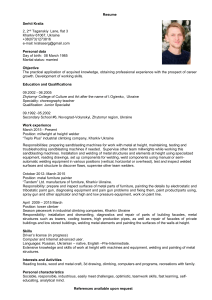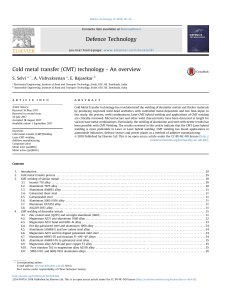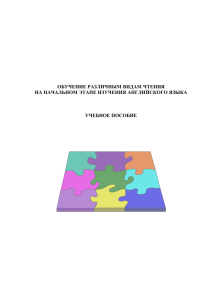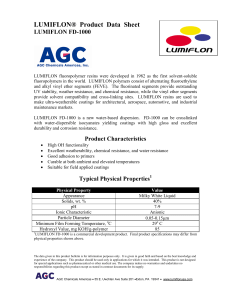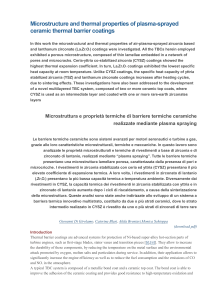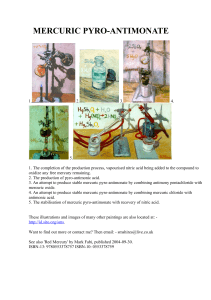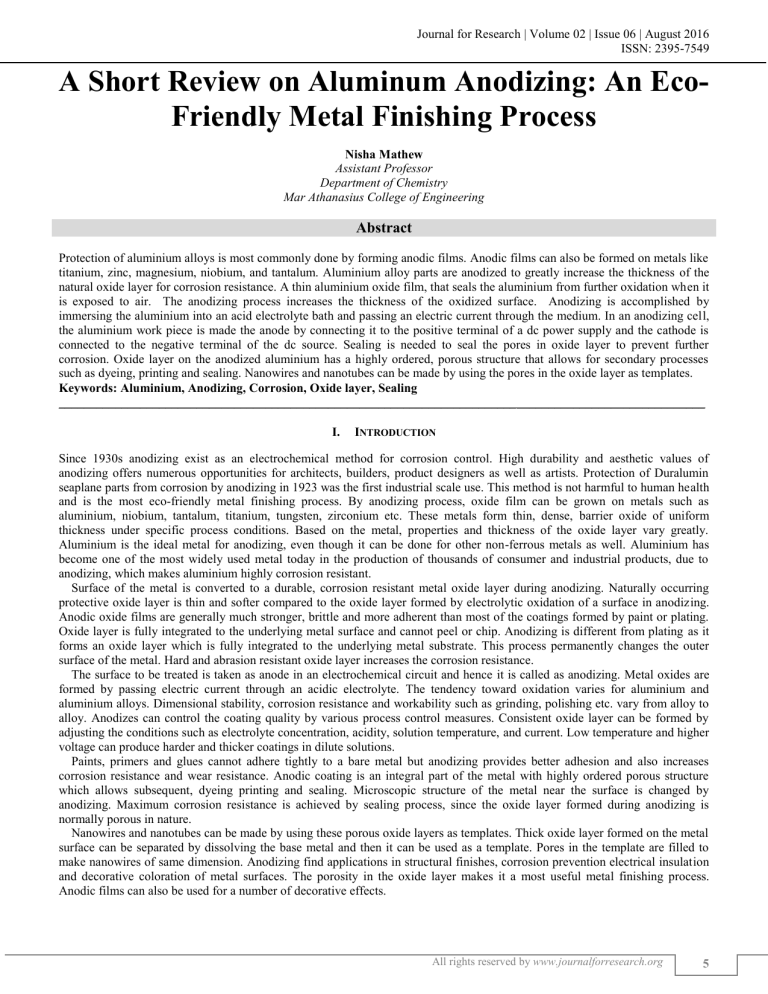
Journal for Research | Volume 02 | Issue 06 | August 2016 ISSN: 2395-7549 A Short Review on Aluminum Anodizing: An EcoFriendly Metal Finishing Process Nisha Mathew Assistant Professor Department of Chemistry Mar Athanasius College of Engineering Abstract Protection of aluminium alloys is most commonly done by forming anodic films. Anodic films can also be formed on metals like titanium, zinc, magnesium, niobium, and tantalum. Aluminium alloy parts are anodized to greatly increase the thickness of the natural oxide layer for corrosion resistance. A thin aluminium oxide film, that seals the aluminium from further oxidation when it is exposed to air. The anodizing process increases the thickness of the oxidized surface. Anodizing is accomplished by immersing the aluminium into an acid electrolyte bath and passing an electric current through the medium. In an anodizing cell, the aluminium work piece is made the anode by connecting it to the positive terminal of a dc power supply and the cathode is connected to the negative terminal of the dc source. Sealing is needed to seal the pores in oxide layer to prevent further corrosion. Oxide layer on the anodized aluminium has a highly ordered, porous structure that allows for secondary processes such as dyeing, printing and sealing. Nanowires and nanotubes can be made by using the pores in the oxide layer as templates. Keywords: Aluminium, Anodizing, Corrosion, Oxide layer, Sealing _______________________________________________________________________________________________________ I. INTRODUCTION Since 1930s anodizing exist as an electrochemical method for corrosion control. High durability and aesthetic values of anodizing offers numerous opportunities for architects, builders, product designers as well as artists. Protection of Duralumin seaplane parts from corrosion by anodizing in 1923 was the first industrial scale use. This method is not harmful to human health and is the most eco-friendly metal finishing process. By anodizing process, oxide film can be grown on metals such as aluminium, niobium, tantalum, titanium, tungsten, zirconium etc. These metals form thin, dense, barrier oxide of uniform thickness under specific process conditions. Based on the metal, properties and thickness of the oxide layer vary greatly. Aluminium is the ideal metal for anodizing, even though it can be done for other non-ferrous metals as well. Aluminium has become one of the most widely used metal today in the production of thousands of consumer and industrial products, due to anodizing, which makes aluminium highly corrosion resistant. Surface of the metal is converted to a durable, corrosion resistant metal oxide layer during anodizing. Naturally occurring protective oxide layer is thin and softer compared to the oxide layer formed by electrolytic oxidation of a surface in anodizing. Anodic oxide films are generally much stronger, brittle and more adherent than most of the coatings formed by paint or plating. Oxide layer is fully integrated to the underlying metal surface and cannot peel or chip. Anodizing is different from plating as it forms an oxide layer which is fully integrated to the underlying metal substrate. This process permanently changes the outer surface of the metal. Hard and abrasion resistant oxide layer increases the corrosion resistance. The surface to be treated is taken as anode in an electrochemical circuit and hence it is called as anodizing. Metal oxides are formed by passing electric current through an acidic electrolyte. The tendency toward oxidation varies for aluminium and aluminium alloys. Dimensional stability, corrosion resistance and workability such as grinding, polishing etc. vary from alloy to alloy. Anodizes can control the coating quality by various process control measures. Consistent oxide layer can be formed by adjusting the conditions such as electrolyte concentration, acidity, solution temperature, and current. Low temperature and higher voltage can produce harder and thicker coatings in dilute solutions. Paints, primers and glues cannot adhere tightly to a bare metal but anodizing provides better adhesion and also increases corrosion resistance and wear resistance. Anodic coating is an integral part of the metal with highly ordered porous structure which allows subsequent, dyeing printing and sealing. Microscopic structure of the metal near the surface is changed by anodizing. Maximum corrosion resistance is achieved by sealing process, since the oxide layer formed during anodizing is normally porous in nature. Nanowires and nanotubes can be made by using these porous oxide layers as templates. Thick oxide layer formed on the metal surface can be separated by dissolving the base metal and then it can be used as a template. Pores in the template are filled to make nanowires of same dimension. Anodizing find applications in structural finishes, corrosion prevention electrical insulation and decorative coloration of metal surfaces. The porosity in the oxide layer makes it a most useful metal finishing process. Anodic films can also be used for a number of decorative effects. All rights reserved by www.journalforresearch.org 5 A Short Review on Aluminum Anodizing: An Eco-Friendly Metal Finishing Process (J4R/ Volume 02 / Issue 06 / 002) II. ALUMINIUM ANODIZING Aluminium is the ideal metal suited for anodizing as it can form barrier as well as porous oxides. Nanoporous oxide layer is formed on aluminium by electrochemical oxidation. Anodization of aluminium is a technique which has been used for several decades. Pure aluminium exhibits passivity by forming a layer of amorphous aluminium oxide 2 to 3 nm thick. This provides effective protection against corrosion and as a result aluminium exhibit more corrosion resistance than expected. Thicker oxide layers of thickness 5-15 nm are formed by aluminium alloys but have more susceptibility towards corrosion. Nanoporous oxide layer is formed on aluminium which allows subsequent workability such as dyeing (colouring) and improves properties such as lubrication and adhesion. Thick barrier oxide layer with thickness2-3 nm is always formed on aluminium next to the metal surface. Barrier oxide layer act as an excellent electrical insulator and stabilize the surface against further reactions with the environment. Porous aluminium oxides are generally grown in dilute sulphuric acid of concentration 10% by weight. Inorganic and organic acids can be used for growing oxide films on the metal surface (E.g. Phosphoric acid, chromic acid, oxalic acid). Mixtures of organic and inorganic acids can also be used for this. Relatively high concentration of aluminium is retained in solution in such baths. This is highly important because a large fraction of aluminium that is oxidized passes into the solution and not retained in the bath. Anodization in sulphuric acid, about 60% of the oxidized aluminium is in the film and the rest is retained by the solution. Well defined aluminium oxide layers are formed by researchers by developing anodization techniques under more controlled conditions. It is possible to tailor the pores in the aluminium oxide layer by suitably adjusting the conditions. The pores in aluminium oxide layer are perpendicular to the underlying aluminium surface, and the voltage can be adjusted during anodizing to control the pore diameter. The possibility to remove the underlying aluminium and there by obtain free aluminium oxide sheets. These aluminium oxide sheets have closely packed parallel pores penetrating through the material. By anodization it is possible to make isoporous aluminium oxide membranes with closely packed pores which are parallel to each other. Pore diameter can be tailored between 10-300 nm and the thickness can be tailored between 300 nm - 100 µm. In order to form consistent oxide layer, conditions such as electrolyte concentration, acidity, solution temperature, and current must be controlled. Dilute acid solution at low temperature with higher voltage tend to produce harder and thicker films. Thickness of the film can range from 0.5 for bright decorative work up to 150 µm for architectural applications. Acidic electrolyte should be selected in such a way that oxide layer should be insoluble or sparingly soluble in the bath and hence an adherent oxide layer grows on the metal surface. The chance of forming barrier or porous oxide is determined mainly by the composition of the bath. Neutral solution helps the formation of barrier oxide, as the oxide is hardly soluble in neutral solution. Ammonium borate, ammonium phosphate or ammonium tartrate is the most commonly used neutral solutions for aluminium anodizing. Acidic electrolyte helps the formation of porous oxide layer. Oxide layer gets deposited as well as dissolves in acidic electrolyte. Anodic coatings are usually formed in chromic acid, sulphuric acid, phosphoric acid or oxalic acid solutions. Sulphuric acid anodizing is preferred for decorative applications, as discolouration of coatings occurs in the widely used chromic acid anodizing. Most widely used bath for anodizing contains 10% by weight concentration of sulphuric acid. Even though colour anodizing is generally done in organic acid bath, the same result can be produced with dilute sulphuric acid. Important variations of aluminium anodizing are chromic (type I), sulphuric (type II) and hard (type III). Oldest anodizing process is the chromic acid anodizing. Thinner (0.5 μm to 18 μm), opaque, soft and ductile self-healing films can be formed in chromic acid. 50% of the oxide penetrates into the surface and 50% grows over the surface which increase the original dimensions occurs. Subsequent dyeing is difficult in this case and it can be applied as a primer coat for paint. Carcinogenic nature of chromic acid reduces the significance of chromic acid anodizing and it has been phased out. Most widely used anodizing method is sulphuric acid anodizing. Thickness of the oxide coating vary from 1.8 μm to 25 μm (0.00007" to 0.001") can be produced by this method. 67% of the oxide coating penetrates into the substrate and 33% grows on the substrate surface. Sulphuric acid anodizing is excellent for colour dyeing due to its permeable nature. Coating formed by this method act as excellent base for primers, paints etc. Oxide coating formed by sulphuric acid anodizing is highly durable and also exhibit very high corrosion resistance. This method can be used for building components, automobile parts, computers, aircrafts etc. Aluminium oxide occupies more space than aluminium and hence will raise the surface. Small holes threaded to accept screws will be affected by anodizing. Threaded holes may need to be chased with a tap to restore the original dimensions because anodizing may cause the screws to bind. Hence oversize taps may be used to pre compensate for this growth. Slightly oversized holes should be made to compensate the dimension change. Thermal conductivity and coefficient of linear expansion are low for anodized aluminium coatings than aluminium. Hence these coatings tend to crack from thermal stress when exposed to temperatures above 80 °C. The coating can crack, but it will not peel as it is integrated to the metal surface. The very high melting point of aluminium oxide (2050 °C) makes welding more difficult when compared to pure aluminium with relatively low melting point (658 °C). Anodized aluminium coating is more hard compared to pure aluminium. Wear resistance can be improved by suitable sealing process and also by increasing the thickness. Aluminium alloys exhibit different tendency during anodization. Aluminium alloys give oxides with different colour based on the alloy. Some of the aluminium alloys are difficult to oxidise. Workability such as grinding, polishing etc. also varies from alloy to alloy. Aluminium alloys exhibit different corrosion resistance after anodizing. Anodizing cannot provide complete corrosion resistance to corrosion prone alloys and hence further protection is usually required. Sulphuric acid electrolyte at low temperature with higher concentration is used for hard anodizing. Hard anodizing result in the formation of tough and thick outer skin with excellent abrasion resistance, corrosion resistance, colour fade resistance, All rights reserved by www.journalforresearch.org 6 A Short Review on Aluminum Anodizing: An Eco-Friendly Metal Finishing Process (J4R/ Volume 02 / Issue 06 / 002) dielectric strength and surface hardness 50% of the oxide formed penetrate in the substrate and 50% grows over the surface. Hard anodized metals have high surface roughness. This is commonly used for utensils, non-decorative food packing equipment, photocopier paper rolls, and exterior applications such as building store fronts and windows. Yellowish integral colours can be produced without dyes, when anodizing is carried out in weak organic acids with high voltages, high current densities, and strong refrigeration. Shades of colour which can be obtained by this method are restricted to pale yellow, gold, deep bronze, brown, grey, and black. White coating with 80% reflectivity by advanced variations of this method. Consistent reproducibility of colour shades is not possible as the colour produced Surfaces can be prepared for adhesives by phosphoric acid anodizing. A thin phosphoric acid anodized coating is used as an adhesive bonding primer coat on aircraft and aerospace alloy sheets. This coating increases the corrosion resistance and act as an excellent base for epoxy adhesive. Boric acid and tartaric acid baths are also employed in anodizing. When the substrate to be coated is fully covered, coating growth stops. The thickness of the coating and the voltage applied are linearly related. Coatings formed by these methods are free of pores when compared to sulphuric and chromic acid processes. This type of coating is widely used to make electrolytic capacitors. III. EXPERIMENTAL PROCEDURE Anodizing is accomplished by immersing the aluminium substrate into an acid electrolyte bath and by passing electric current through the acidic electrolyte. The aluminium article to be anodized is made the anode by connecting it to the positive terminal of a dc power supply. The cathode is connected to the negative terminal of the dc source. The cathode is usually an inert electronic conductor which is unreactive in the acidic anodizing bath. Commonly used inert electrodes are a plate or rod of carbon, lead, nickel, stainless steel etc. When the circuit is closed, aluminium substrate at the anode release electrons and form aluminium ions at the surface. These metal ions at the surface react with water to form an oxide layer on the metal. At the cathode electrons are accepted by hydrogen ions, which get reduced to form hydrogen gas. Oxygen ions are released from the electrolyte to combine with aluminium ions, to form aluminium oxide at the surface. In order to enhance the naturally occurring oxidation process, anodizing must be done in a highly controlled manner. Fig. 1: Experimental Procedure The overall reaction that takes place during anodization is given below: 2Al + 3H2O ==> Al2O3 + 3H2 Aluminium part to be anodized is first cleaned to remove surface dirt by dipping in hot cleaning agent. Then it is rinsed to avoid contamination. It has to be then dipped in acidic solution to remove non-uniform aluminium oxide surface. Then again it is rinsed to avoid contamination. Etching in sodium hydroxide solution is done in order to remove the natural shine of aluminium and to provide a soft, matte, textured appearance. This part is then suspended in anodizing tank which contains dilute acid solution. Desired finish and colour depends on the concentration and type of acid and also on the temperature of the solution. The amount of current used for anodizing depends on the amount of surface to be treated. In order to provide uniform solution throughout anodizing, it has to be agitated periodically. Thicker coatings are formed on the surface near to the cathode. Time of treatment depends on the nature and quality of coating. Acidic solution used in aluminium anodizing may slowly dissolve the aluminium oxide and hence produce pores in the anodized coating. The highly ordered porous structure of aluminium oxide coating allow subsequent processes such as dyeing, printing, sealing and retain lubricants, but may lead to corrosion. The acid action is balanced with the oxidation rate to form a coating with nanopores, 10-150 nm in diameter. These pores allow the electrolytic solution and current to reach the aluminium substrate and hence continue oxidation to form coatings with greater thickness beyond that formed by auto passivation. However if these pores are not sealed corrosion will start slowly, as these pores allow air or water to reach the substrate. They are often filled with coloured dyes and/or corrosion inhibitors before sealing. After dyeing it has to be sealed, because the dye is only superficial and the underlying oxide may continue to provide corrosion protection even when minor wear and scratches break through the dyed layer. Organic or inorganic dye can be used however the colour shades produced tend to vary according to the base alloy. Light fastness of organic dye is a concern as red and blue colours are particularly prone to fading. Sealing is essential All rights reserved by www.journalforresearch.org 7 A Short Review on Aluminum Anodizing: An Eco-Friendly Metal Finishing Process (J4R/ Volume 02 / Issue 06 / 002) for dyed surfaces to prevent fading of the dye. Aluminium substrate is the dipped in organic dye solution in water to impart to colour. Time and temperature required for giving colour depends on the type of dye used. Digital printer, silkscreens or sublimation transfer can be used to print photo quality images and graphics in vivid colour into the unsealed porous aluminium oxide layer. Printers can be used to achieve line art quality graphics on the anodized aluminium part. Images in colour can be directly painted on the anodized aluminium substrate by using airbrush, sponge or paint brush with hand. Printed anodizing part has to be sealed to prevent or reduce dye bleed out. Without sealing the pores, the usefulness of this method would be quite limited. Anodized surface without sealing undergoes corrosion gradually. Sealing of the pores can be done by different methods. The Al2O3 coating produced by anodizing is typically 2µm to 25µm thick, and consists of a thin non-porous barrier layer next to the metal with a porous outer layer that can be sealed by hydrothermal treatment. Hydrothermal method of sealing is done by dipping aluminium substrate in boiling de-ionized water or steam for 20-30 minutes for sealing the pores in non-dyed coatings. Long immersions can be done but it reduce abrasion resistance by 20% and hence not a completely effective method. Oxide on the surface and pores reacts to make a hydrated metal oxide (Al 2O3.H2O) with a different structure, and a lower density when compared to the metal oxide (Al 2O3). Because of its lower density, the hydrated metal oxide occupies more volume than the metallic oxide from which it is formed. Hydrated aluminium oxide fills the pores makes it an impermeable layer that is stable under various environmental conditions. This method of sealing converts Al2O3 to Al2O3.H2O. More solid crystalline hydrate form of Al2O3 occupies more volume than Al2O3 and hence the pores are sealed. Cold sealing is done by impregnation of a sealant at room temperature. This has become a popular method because of its less energy requirement. But the coatings sealed by this method are not suitable for adhesives. Hot metal salt solutions such as a chromate or dichromate used in sealing improve corrosion resistance. For dyed anodized parts, sealing is done in nickel acetate solution. Usually in commercial oxidation process, aluminium oxide is grown down into the surface and out from the surface by equal amounts. As a result dimension of the aluminium part subjected to anodizing increases by half of the oxide thickness. IV. ADVANTAGES OF ANODIZED COATINGS 1) Maintenance of anodized coatings are easy because it can be cleaned with mild soap and water solution to restore its original appearance 2) Colour alternatives and glossy metallic appearance offer aesthetic values to anodizing 3) Low processing and maintenance costs make it a cost effective process 4) Good external appearance of anodized coatings make it a useful and popular metal finishing process 5) These coatings do not chip or peel as it is integrated to the substrate which makes it more durable. Durability also reduce the replacement cost 6) Anodized coatings exhibit colour stability when exposed to UV rays 7) Anodizing is one of the most eco-friendly metal finishing methods which are not harmful to human health. The by-products do not contain heavy metals or halogens except in case of organic anodizing 8) Anodized coatings are chemically stable and do not decompose 9) Non-toxic nature and high heat resistance of anodized coatings make it a valuable method for corrosion prevention in aluminium utensils 10) The most common anodizing effluents such as Al(OH)3 and Al2(SO4)3 are recycled for the manufacture of various products V. APPLICATIONS Anodized finishes have made aluminium one of the most respected and widely used materials today in the production of thousands of consumer, commercial and industrial products because of its aesthetic values, environmental safety, external appearance etc. This method is widely used in various fields like construction of computer hardware, display boards for trade shows, manufacture of scientific instruments, home appliances, and building materials. 1) Home Appliances: Appliances such as refrigerators, dryers, coffee brewers, cooking ranges, televisions, mp3 players, flashlights, cookware, cameras, microwaves, grills. Television 2) Building Components: Door handles, window frames, exterior structural panels, curtain walls, roofing systems, vents, dust covers, light fixtures, mailboxes, bathroom accessories, , wall switch plates for buildings. ceilings, floors, escalators 3) Automobiles: Motor vehicle components such as trim parts, wheel covers, control panels, panels, and name plates. 4) Furniture: Tables, beds, files and storage cabinets 5) Domestic application: clocks and electronic products, fire extinguishers, photo equipment, solar panels, telephones, picture frames, cooking utensils 6) Aerospace: Exterior panels for aerospace vehicles, aircraft landing gear components and jet engine control valves, and pistons. Anodizing gives protection to satellites from the harsh environment of space. 7) Leisure: Camping and fishing equipments 8) Sports and Leisure: Sporting goods such as golf carts, boats 9) Food Industry: Food processing & handling equipments, pans, coolers, and grills All rights reserved by www.journalforresearch.org 8 A Short Review on Aluminum Anodizing: An Eco-Friendly Metal Finishing Process (J4R/ Volume 02 / Issue 06 / 002) 10) Medical Equipments: Surgical cases, trays, surgical instrument handles, dental components, medical handling and processing equipment 11) Nanotechnology: Pores in the anodized coatings can be used as templates to make structures such as nanowires and nanotubes. VI. CONCLUSIONS When aluminium is exposed to air it naturally develops a thin aluminium oxide film that seals the aluminium from further oxidation. The anodizing process increases the thickness of the oxide layer and it forms thicker oxide layer compared to natural oxide layer. Abrasion resistance of aluminium increases by anodizing as the hardness of the anodized aluminium oxide coating is high. The increased thickness of the oxide layer enhances the corrosion resistance of the aluminium and also making the cleaning process an easier one. Consistent oxide layer can be formed by controlling the conditions such as electrolyte concentration, acidity, solution temperature, and current. Harder and thicker films are produced in dilute solutions at lower temperatures when a high voltage is used. This result in the formation of film with thickness (0.5µm to 150 µm), which find decorative as well as architectural applications. Wear resistance of anodized aluminium surfaces can be improved by increasing the thickness or by sealing process. Stronger, adherent and brittle films than paint and metal plating, are formed by this method. This aluminium oxide cannot chip or peel and it is fully integrated with the underlying aluminium substrate. Secondary processes such as dyeing and sealing are possible due to the formation of highly ordered porous oxide. Aluminium oxide layer gets slowly dissolved in the acid bath used for anodizing. Anodized finishes have made aluminium one of the most respected and widely used materials today in the production of thousands of consumer, commercial and industrial products. The aesthetically pleasing results of anodizing combined with the functional benefits of increased durability offer numerous design opportunities for architects, builders, product designers as well as artists. Pores in the oxide layer can be used as templates to make structures such as nanowires and nanotubes. REFERENCES O. G. Palanna, “Corrosion Science”, in Engineering Chemistry, 1 st ed. New Delhi: Tata McGraw Hill Education Private Ltd., 2009, pp-137. Edwards, Joseph, Coating and Surface Treatment Systems for Metals: Finishing Publications Ltd. and ASM International, 1997, pp. 34–38. M. A. Biason Gomes, S. Onofre, S. Juanto, L. O. de S. Bulhões, “Anodization of niobium in sulphuric acid media,” Journal of Applied Electrochemistry, vol. 21, no. 11, pp. 1023–1026, 1991. [4] H. Uchi, T. Kanno, R. S. Alwitt, “Structural Features of Crystalline Anodic Alumina Films,” Journal of The Electrochemical Society, vol. 148, no. 1, pp. B17-B23, Jan. 2001. [5] H. Asoh, K. Nishio, M. Nakao, T. Tamamura, H. Masuda, “Conditions for Fabrication of Ideally Ordered Anodic Porous Alumina Using Pretextured Al,” Journal of The Electrochemical Society, vol. 148, no. 4, pp. B152-B156, Apr. 2001. [6] http://en.wikipedia.org/wiki/Anodizing [7] http://www.focuser.com/anodize.html [8] http://electrochem.cwru.edu/encycl/art-a02-anodizing.html [9] http://www.defelsko.com/applications/anodizing/Anodizing.html [10] http://www.anodizing.org/Anodizing/definitions.html [1] [2] [3] All rights reserved by www.journalforresearch.org 9
